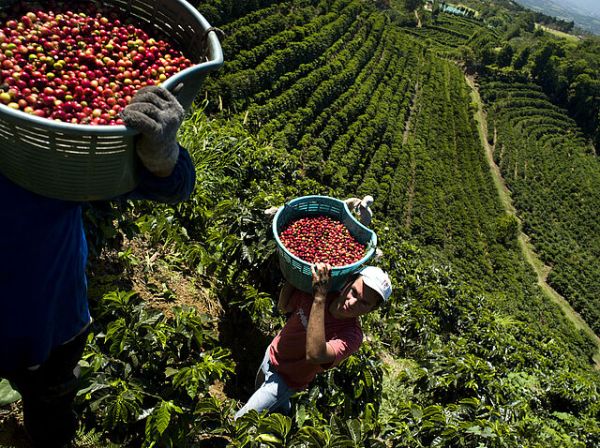Costa Rica Celebrates Transformational Change in Coffee Production

Over 200 attendees celebrated the transformational change initiated in Costa Rica’s coffee sector by way of the first agricultural NAMA in the world at the NAMA Support Project’s closing event on October 18th, 2019.
After four years of implementation, the NAMA Support Project “Low-Carbon Coffee Costa Rica” celebrated its impressive results together with over 200 key players from major stakeholder groups of the sector. In attendance to celebrate the hard work of past years and continuing efforts were political participants, including the vice ministers of agriculture and energy, German Ambassador to Costa Rica, the country director of GIZ and the director of the Central American Bank for Economic Integration (CABEI); 30 coffee producers from the country’s eight coffee regions and representatives from most of the 62 partner coffee mills.
“When we started with this initiative, many coffee producers had no idea of the impact their crop had on climate change and vice versa – and even less of what to do about it. Only a few years later, 22% of Costa Rican coffee is produced in a sustainable manner emitting the least possible amount of greenhouse gas emissions”, expressed Ana Cristina Quirós, Vice Minister of Agriculture, at the event.
“The coffee sector has shown great leadership on a national as well as international level in order to consolidate a low-carbon coffee production. All of you are pioneers in the fight against climate change and a model to follow”, Rolando Castro, Vice Minister of Energy, said as he congratulated the coffee producers in attendance.
Results of the Support Project Café
Over 8,900 producers on 25,000 hectares (22% of the national coffee production area) were trained in applying good agricultural practices (GAPs) in order to adapt to changing climate conditions, minimize the impact of illnesses and pests and maintain crop productivity. 84% currently apply at least two GAPs on their farms. Luz Mery Vásquez from Hojancha has noticed an astounding impact on her plantation’s productivity: “We have more than doubled our harvest in just one year thanks to the application of good agricultural practices on our farm. Thus, I am very grateful to have been invited to participate in the project’s trainings.”
62 coffee mills (24% of those officially registered) were accompanied in the annual measurement of their GHG inventories by way of capacity building and technical assistance in order to reduce GHG emissions, water and energy consumption. To facilitate necessary investments and acquisition of equipment, a credit line of US$8 million was launched in cooperation with CABEI. Additionally, over US$3.8 million has been mobilized in private funds.
Gabriela Fernández of Cordillera de Fuego coffee mill took advantage of this financial mechanism – and has noticed a considerable impact: “A new drying patio has reduced 50 per cent of our electricity consumption. Our newly acquired intelligent dryer has reduced the use of firewood and coffee husk by 75 per cent and significantly reduces drying time.”
In order to successfully position the world’s first low-carbon coffee on international markets and exploit its added value, 21 commercial managers improved their marketing and sales skills; 15 have managed to position their coffee on German and U.S. markets.
“The world is demanding low-carbon coffee and rewarding the application of good agricultural practices. We now use this added value as a marketing tool”, states Mario Sibaja from Coopevictoria, one of the biggest coffee processing cooperatives in the country. Ignacio Ceciliano from the micro-mill Río Conejo Estate adds: “Thanks to the project we were able to participate in one of the largest coffee expos in the world, the SCA in Seattle, where we managed to sell our low-carbon coffee to a local coffee roaster.”
Outlook and Future Challenges
In December 2019, most technical activities within the NSP Café will conclude. GIZ will solely accompany the implementation of the credit line with CABEI during 2020.
“We are very grateful to GIZ and the NAMA Facility for their invaluable support in the past four years in the ambitious initial stage of this NAMA. We have institutionalized several key processes for future follow-up and continuous implementation, and between ICAFE, the Ministry of Environment and the Ministry of Agriculture we are highly committed to expanding the results of the NSP Café to include the rest of the sector”, confirmed Ana Cristina Quirós in her compelling speech.
While the Ministry for Agriculture will focus particularly on continuing capacity building for farmers and the ministry’s advisory personnel, the Ministry for Environment will follow up on the sector’s MRV system, including monitoring emission reductions in the upcoming years.
ICAFE will provide assistance to current and future partnering mills in measuring greenhouse gas emissions and reductions. Additionally, the institution has included the NAMA Café as one of eight pillars of its Traceability and Sustainability Statement, which aims to inform buyers and consumers in a transparent manner on every detail of the production and processing of Costa Rican coffee and will support the positioning of low-carbon coffee on international markets.
Please note: by clicking on the links above you will be redirected to YouTube. You hereby give your consent for YouTube to use cookies on the device you are using. Learn more under Privacy.
Watch Luz Mery Vásquez’s account on the Support Project.
Find out what Gabriela Fernández thinks about the project.
View Mario Sibaja’s opinion on Low-Carbon Coffee.
Watch Ignacio Celilano’s statement.
Watch additional testimonials on Youtube.
Need more hard facts? Check out our results infographic (Spanish only).
Find out more about the project on the website.
Read the Traceability and Sustainability Statement of ICAFE.

